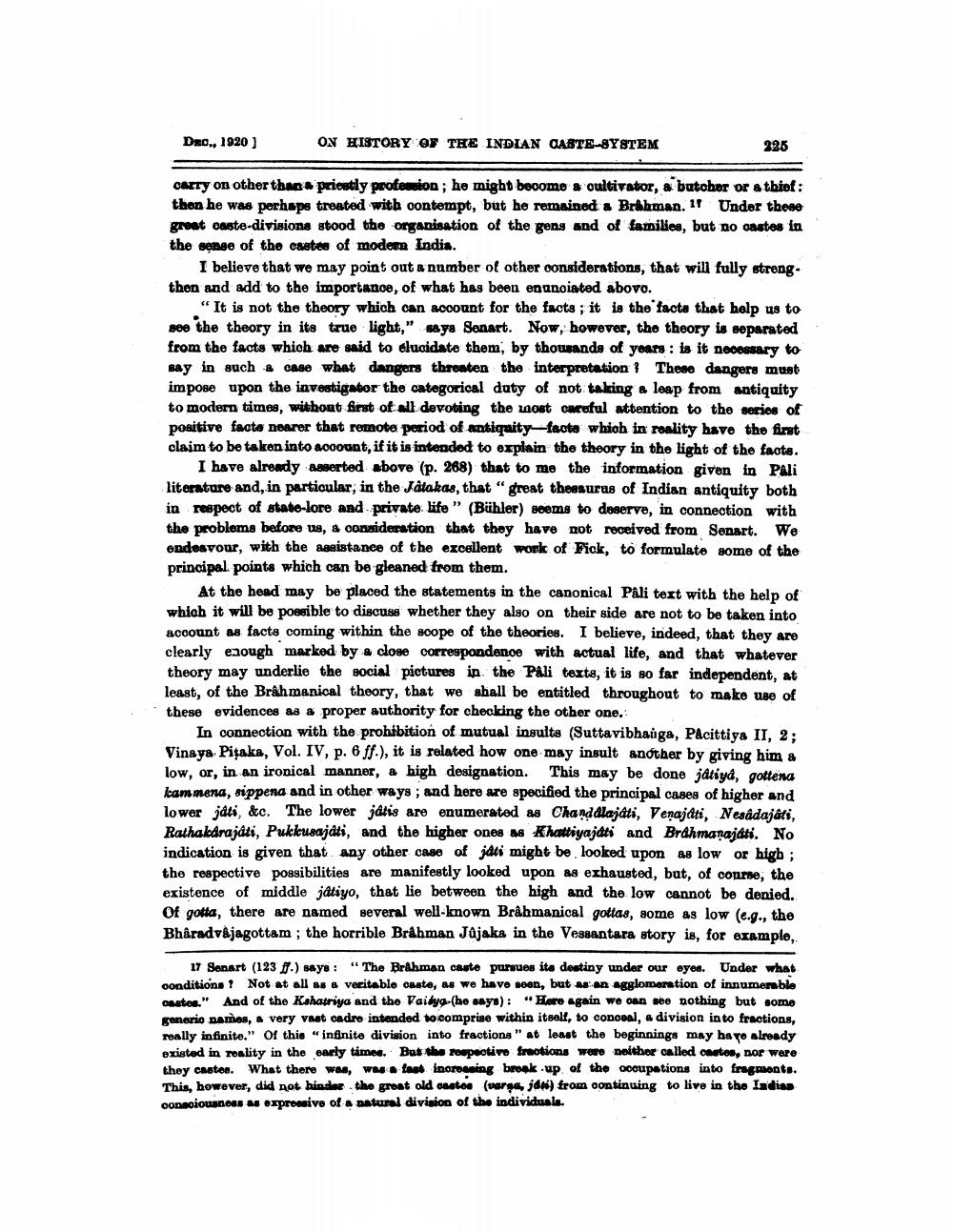________________
DRO., 1920 )
ON HISTORY OF THE INDIAN CABTE-SYSTEM
326
-
carry on other thao# priestly profesion; he might become a cultivator, a butober or a thief: then he was perhaps treated with contempt, but he remained a Brahman. 11 Under these great oaste-divisions stood the organisation of the gens and of families, but no castes in the sense of the castle of modern India.
I believe that we may point out a number of other considerations, that will fully streng. then and add to the importance, of what has been enunciated abovo.
" It is not the theory which can acoount for the facts; it is the facts that help us to see the theory in its true light," says Senart. Now, however, the theory is separated from the facts which are said to elucidate them, by thousands of years: is it necessary to say in such a case what dangers threaten the interpretation: These dangers must impose upon the investigator the categorical duty of not taking a leap from antiquity to modern times, without first of all devoting the most careful attention to the series of positive facta noaror that remote period of antiquity-facta which in roality have the first claim to be taken into account, if it is intended to explain the theory in the light of the facts.
I have already asserted above (p. 268) that to me the information given in Pali literature and, in particular, in the Jatakas, that "great thesaurus of Indian antiquity both in respect of stato-lore and private life " (Bühler) seems to deserve, in connection with the problems before us, & consideration that they have not received from Senart. We endeavour, with the assistance of the excellent work of Fick, to formulate some of the principal points which can be gleaned from them.
At the head may be placed the statements in the canonical Pali text with the help of which it will be possible to discuss whether they also on their side are not to be taken into account as facts coming within the scope of the theories. I believe, indeed, that they are clearly enough marked by a close correspondenoe with actual life, and that whatever theory may underlie the social pictures in the Pali texts, it is so far independent, at least, of the Brah manical theory, that we shall be entitled throughout to make use of these evidences as a proper authority for checking the other one.
In connection with the prohibition of mutual insults (Suttavibhaga, Pacittiya II, 2; Vinaya Pitaka, Vol. IV, p. 6 ff.), it is related how one may insult another by giving him a low, or, in an ironical manner, a high designation. This may be done jatiya, gottena leammana, sippena and in other ways; and here are specified the principal cases of higher and lower jati, &c. The lower jatis are enumerated as Chand Alajati, Venajati, Nesådajati, Rathakarajati, Pulkusajati, and the higher ones as Khattiyajáti and Brahmarajati. No indication is given that any other case of jati might be looked upon as low or high; the respective possibilities are manifestly looked upon as exhausted, but, of course, the existence of middle jatiyo, that lie between the high and the low cannot be denied. Of gotta, there are named several well-known Brahmanical gottas, some as low (e.g., the Bhâradvajagottam; the horrible Brahman Jûjaka in the Vessantara story is, for example.
17 Sonart (123 .) says: "The Brahman caste pursues ita destiny under our eyes. Under what conditions ? Not at all as & veritable caste, as we have seen, but as an agglomeration of innumerable costes." And of the Kshatriya and the Vaidya-(he sayo): "Here again we can see nothing but some generio dares, a very vast cadre intended to comprise within itself, to conoval, a division into fractions, really infinite." of this "infinite division into fractions" at least the beginnings may have already existed in reality in the early times. But the respective frections were neither called custos, nor were they castes. What there was, was a fast inoroening brook up of the occupations into fragments. This, however, did not hinder the great old costos (warga jdm) from oontinuing to live in the Ladies coniousnous a expressive of a natural division of the individuale.




